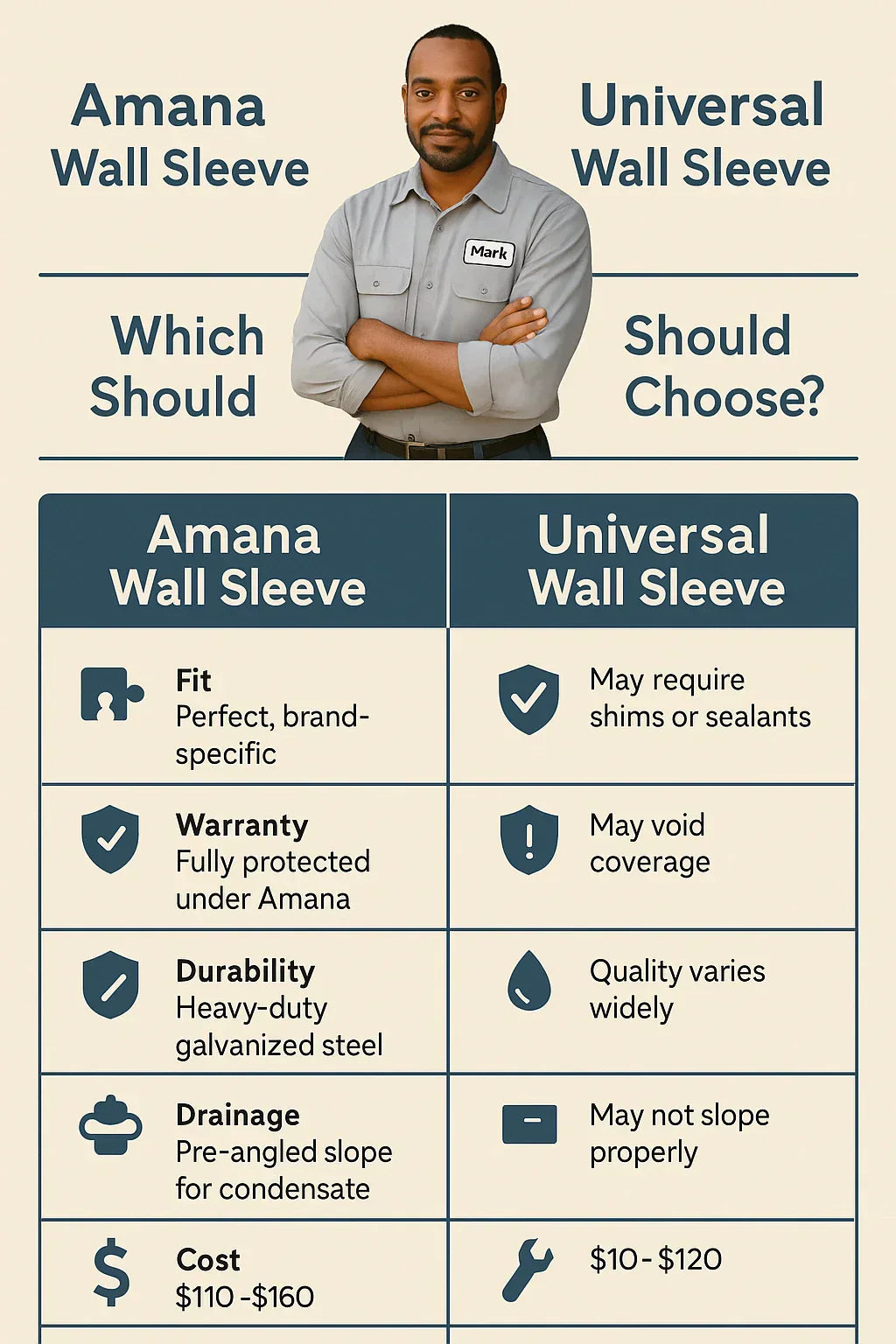When I (Mark) was setting up my Amana through-the-wall air conditioner, I had a decision to make: spend more on the Amana brand wall sleeve or save a few bucks with a universal sleeve. At first, the cheaper option looked appealing. But after trying both, I learned the hard way that the choice of sleeve can make or break your installation.
Amana Through-the-Wall Air Conditioner Wall Sleeve
In this guide, I’ll walk you through the pros, cons, costs, and long-term differences between Amana and universal wall sleeves—so you don’t waste time or money like I did.
📌 What Is a Wall Sleeve and Why Does It Matter?
Before we get into comparisons, let’s back up: what exactly is a wall sleeve?
A wall sleeve is a durable metal (or sometimes heavy plastic) frame that slides into your wall cut-out. The AC unit itself then slides into the sleeve.
👉 Think of the sleeve as the foundation of your through-the-wall AC system. Without it, your unit would:
-
Sit unevenly
-
Leak air and water
-
Be vulnerable to pests and drafts
-
Lack proper structural support
According to the U.S. Department of Energy (DOE), poor installation can reduce efficiency by 20–30%, and much of that is tied to sealing and framing . That’s where the sleeve comes in—it ensures a tight, stable fit.
🔧 Why Amana Designed Its Own Wall Sleeve
Amana wall sleeves aren’t just generic boxes; they’re engineered specifically for Amana ACs. Here’s why that matters:
-
Precise dimensions: Amana sleeves are a standard 26” width, built to align with Amana’s units.
-
Drainage slope: Built-in tilt so condensation drains outdoors.
-
Warranty protection: Many Amana warranties require a brand-approved sleeve .
-
Durability: Heavy-gauge galvanized steel resists rust and weathering.
When I slid my Amana AC into the Amana sleeve, it fit snugly—no gaps, no rattling, and no worries about warranty issues.
🔄 Universal Wall Sleeves: One Size Fits All (Or Does It?)
Universal sleeves are marketed as a flexible alternative that works with multiple brands. They’re often cheaper ($70–$120 compared to $110–$160 for Amana).
But here’s the catch:
-
Fit is hit-or-miss. Even a ½-inch gap means extra caulking or shims.
-
Energy efficiency suffers. Air leaks lead to higher utility bills.
-
Warranty risk. Amana may not honor warranties if the unit wasn’t installed with its sleeve.
-
Drainage issues. Many universal sleeves don’t have the precise tilt needed, causing water buildup inside.
When I tried a universal sleeve, my AC sat slightly off-balance. That caused vibration noise and even some water pooling.
📊 Side-by-Side Comparison: Amana vs. Universal
Here’s how they stack up:
| Feature | Amana Wall Sleeve | Universal Wall Sleeve |
|---|---|---|
| Fit | Perfect, brand-specific | May require shims or sealants |
| Warranty | Fully protected under Amana | May void coverage |
| Durability | Heavy-duty galvanized steel | Quality varies widely |
| Drainage | Pre-angled slope for condensate | May not slope properly |
| Cost | $110–$160 | $70–$120 |
| Installation Ease | Slide-in, simple alignment | May require adjustments |
👉 Mark’s Take: The Amana sleeve might cost a little more, but it saves you headaches down the road.
💵 The Real Cost: Short-Term Savings vs. Long-Term Value
At first glance, saving $50 with a universal sleeve feels smart. But here’s what you risk:
-
Higher energy bills: A leaky installation can add $100+ a year in lost cooling .
-
Water damage: Moisture intrusion can ruin drywall or framing (costly repairs).
-
Reduced AC lifespan: Stress from poor alignment can shorten unit life.
-
Warranty denial: Amana may refuse to cover a repair if the wrong sleeve was used.
That $50 “savings” can easily cost you hundreds—or even thousands—in the long run.
🌡️ Energy Efficiency & Comfort Differences
The Environmental Protection Agency (EPA) notes that sealing and insulation are key to energy savings .
Amana sleeves include:
-
Foam gaskets around the edges
-
Galvanized steel for thermal stability
-
Rear drain spout for moisture management
Universal sleeves? They may skip one or more of these features, leaving you with drafts or uneven cooling.
I noticed a big difference: with my Amana sleeve, the room cooled faster and the AC cycled less often.
🧰 Installation: DIY vs. Pro Considerations
Installing an Amana Sleeve
-
Straightforward process: cut opening, insert sleeve, seal edges.
-
Perfect fit means less caulking and adjustment.
-
Great for DIYers like me.
Installing a Universal Sleeve
-
Often requires extra sealing, shimming, or adjustments.
-
If not perfectly level, the AC will vibrate.
-
Pros may charge more if the sleeve complicates installation.
👉 If you’re new to DIY projects, Amana sleeves are far less frustrating.
🚨 When Universal Sleeves Might Be Acceptable
To be fair, there are cases where a universal sleeve can work:
-
Temporary setups (like a workshop or garage).
-
Rental properties where you just need a low-cost install.
-
If your existing cut-out is oversized, and the universal sleeve happens to fit better.
But for your main living space, I wouldn’t recommend it.
🏠 Mark’s Recommendation
If you’re installing an Amana through-the-wall AC, go with the Amana wall sleeve. Here’s why:
-
It guarantees a perfect fit.
-
It protects your warranty.
-
It improves efficiency and comfort.
-
It avoids long-term repair costs.
Universal sleeves only make sense in rare, cost-driven cases where performance isn’t a priority.
🔗 Verified External Resources
🏁 Final Thoughts
I learned the hard way: the wall sleeve you choose matters more than you think. Saving a few bucks upfront on a universal sleeve can lead to higher bills, more noise, and water leaks.
My advice as a homeowner? Match your Amana AC with the Amana wall sleeve. It’s a small investment that pays off in efficiency, comfort, and peace of mind.
In the next topic we will know more about: Installation Guide: How Mark Installed His Amana Wall Sleeve







